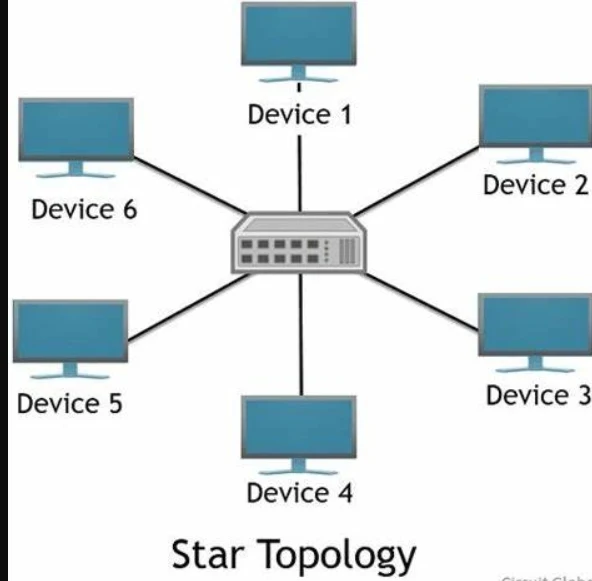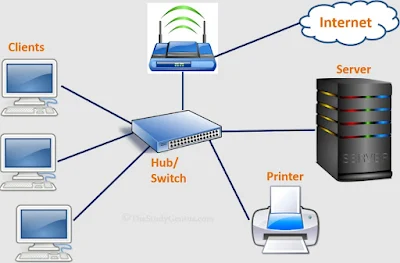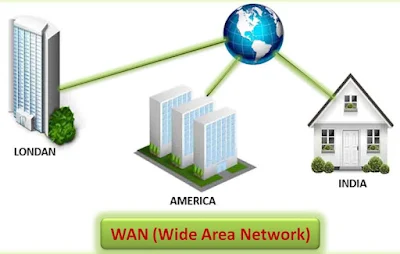Class 8 Computer Notes
Chapter 1: Computer Networking and Security
📡 What is Networking?
➥ Networking means connecting two or more computers to share data, files, and resources like printers and the internet.
eg Computers connected in a school computer lab form a network.

🖥️ What is a Computer Network?
➥ Computer Network is a group of interconnected computers that can communicate with each other.
➯ hese networks help us to communicate, share resources, and access information easily.

✅ Advantages of Computer Networks
- File Sharing: Easily send or receive files between computers.
- Resource Sharing: Use printers, internet, or software from any connected computer.
- Fast Communication: Chat, email, or video call in no time.
❌ Disadvantages of Computer Networks
- Security Issues: Risk of virus attacks and hacking.
- High Cost: Initial setup and maintenance can be expensive.
- Network Failure: If the network is down, all connected devices stop working together.
🔗 Classification of Computer Networks
- PAN (Personal Area Network) - Small network for personal devices (e.g., Bluetooth between phone and laptop).
- LAN (Local Area Network) - Network in a small area like a school or office building.
- MAN (Metropolitan Area Network) - City-wide connection.
- WAN (Wide Area Network) - Large geographical area like internet.
🛠️ Devices Used in a Network
- Router: Connects different networks and sends data between them.
- Switch: Connects devices within a network and shares data among them.
- Hub: Sends data to all devices in the network (less smart than a switch).
- Modem: Connects the network to the internet.
- NIC (Network Interface Card): A card inside the computer that helps it connect to a network.

🔄 Network Topologies
1. Bus Topology: All computers are connected using a single cable.

2. Star Topology: All computers are connected to a central device like a switch or hub.

3. Ring Topology: Computers are connected in a circle. Data moves in one direction.

4. Mesh Topology: Each computer is connected to every other computer in the network.

📶 Data Transmission Media
1. Wired (Bounded) Media:
- Twisted Pair Cable: Used in homes and offices.
- Coaxial Cable: Used for cable TV and internet.
- Optical Fiber: Very fast and used for long-distance connections.

2. Wireless (Unbounded) Media:
- Bluetooth: Short-range connection for phones, speakers, etc.
- Wi-Fi: Connects devices to the internet wirelessly.

🗂️ Accessing Shared Networks
➥ Users can access shared folders, files, and printers over the network easily and securely.

🔒 Network Security
- Use Strong Passwords: Never use easy-to-guess passwords.
- Install Antivirus: To protect from viruses and malware.
- Use Firewalls: To block unwanted access to your computer.
- Update Software: Always keep your system updated to fix bugs and security holes.

Computer Networks Worksheet
A. Tick (✔) the correct option:
- The device that distributes a network connection to all the computers in the network: ✔ c. Both (a) and (b)
- Which of the following can be used to connect two separate LANs? ✔ b. Router
- A ________ can be set up for a city: ✔ c. MAN
- The cables that use light beams through a glass-bound fiber to transmit data: ✔ c. fiber optic cables
- Which statement is not correct? ✔ a. A computer network is always secure.
B. Fill in the blanks with suitable words:
- A number of devices arranged together in order to exchange data and information constitutes a network.
- Computers are mostly connected through cables in a system called a wired network.
- The server manages and controls other devices connected to the network.
- The NIC is also called an Ethernet card.
- The fiber optic cables provide the highest data transmission speed.
- The Wi-Fi works on wireless radio frequency technology.
C. Write 'T' for True and 'F' for False:
- You can share data files around the computers connected to the network. — T
- Wireless networks are usually used in small LANs. — T
- PANs are set up for personal use only. — T
- Client-server networks specifically consist of a server and other systems. — T
- A switch is like a hub with advanced features. — T
D. Answer the following questions:
- What do you mean by a computer network?
A computer network is a collection of interconnected computers and other devices that can share resources and data with each other. - How can you classify computer networks on the basis of the role of a computer in the network?
Computer networks can be classified as Peer-to-Peer and Client-Server based on their role. - Define network topology. What are the different types of network topologies?
Network topology is the arrangement of different elements (links, nodes, etc.) in a computer network. Types: Star, Ring, Bus, Mesh, Tree. - What is the difference between the bounded and unbounded transmission media?
Bounded media use physical cables (e.g., coaxial, twisted pair), while unbounded media transmit data wirelessly (e.g., radio waves, microwaves). - State some ways to protect a wired or wireless computer network from possible threats.
Use of firewalls, antivirus software, strong passwords, encryption, disabling unused ports, and regular software updates.
E. Define the following terms:
- Nodes: Devices like computers, printers, etc., connected to a network.
- Cables: Physical media used to connect network devices for data transmission.
- Hub: A device used to connect multiple network devices, transmitting data to all connected devices.
- Server: A powerful computer that provides resources and services to other computers (clients) on the network.
- Wi-Fi: A wireless technology that allows devices to connect to a network using radio waves.
Subscribe to My Channel








No comments:
Post a Comment